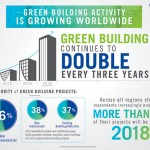 |
| Reviews and Templates for Expression We |
The No. 1 Green Building Benefit: Lower Operating Costs

The building industry is rapidly developing new technology to manage emissions and improve energy efficiency and water management, while also lowering operating expenses.
“Commercial and industrial property owners who oversee green buildings will see a significant savings across energy, trash, water and maintenance costs,” says USGBC spokeperson Leticia McCadden. “Over the next four years (2015-2018), the green construction industry is expected to save $2.4 billion in energy.”
This was evident the US Green Building Council’s Greenbuild 2015 last week. And according to a new green building trends report previewed at the event about 70 percent of survey respondents cite lower operating costs as the greatest benefit of green building.
“Green buildings are better for the environment, better for business and better for the people within them,” says John Mandyck, United Technologies Corp. chief sustainability officer. “Green building activity continues to accelerate, with growing awareness of occupant and tenant benefits, speaking to the fact that the real, tangible benefits of green buildings are becoming more widely recognized.”
Green Building Doubling Every Three Years
United Technologies Corp co-funded the World Green Building Trends 2016 report by Dodge Data & Analytics. It surveyed 1,000 building professionals from 69 countries, building on 2008 and 2012 research, and found respondents across all regions studied projected that more than 60 percent of their projects would be green projects by 2018, with a doubling from current projects across the Middle East, North Africa, Asia, South America and Sub-Saharan Africa.
The largest percentage of green building activity continues to be in the commercial building segment, comprising 46 percent of respondents’ future green building projects. Activity in institutional buildings — schools, hospitals and public buildings — is expected to surpass green building projects in existing buildings (38 and 37 percent respectively) by 2018.
The full findings of the report, which will be available in 2016, reaffirm 2008 and 2012 research that green building is doubling every three years.
Forty percent of respondents noted client demands as a driver for green building activity, followed by environmental regulations (35 percent). Both categories increased over 2008 and 2012 responses. From an environmental perspective, reducing energy consumption (84 percent) and reducing water consumption (76 percent) topped the list as important.
Water Management an Emerging Focus Area
Benjamin Freas, Navigant Research senior research analyst, said at Greenbuild he heard more interest in water management as well as how buildings fit into smart cities. Water management in buildings is an area Navigant continues to watch as well.
“Water has historically been too cheap to worry too much about in commercial buildings,” Freas says. “Increased focus on water scarcity and declining prices of control hardware is starting to unlock the water management market.”
Another area for growth is in building controls. As HVAC, lighting and other equipment become increasingly efficient, future efficiency gains will rely on managing how the equipment operates, Freas says.
Green Building Challenges
“The biggest change in building controls is the continuing convergence of IT and building technology,” he says. “This is enabling better integration between building systems and providing more data to building systems. In turn, with more data, buildings can operate beyond the scope of optimized local systems to improving operation on a building level.”
While an “unprecedented level” of green building technology has emerged to keep occupants comfortable while reducing operating expenses, the challenge to building owners and operators is the cost-effective implementation of this technology, Freas says. Big data allows buildings to run more efficiently and these high-tech features help building owners better attract and retain tenants.
“The biggest opportunity comes from how to deliver this functionality,” Freas says. “It will be an internet of things platform. But, will it be traditional building controls companies adapting their offerings to the internet? Will it be IT infrastructure companies pulling building networks into their purview? Will it be consumer electronics manufacturers leveraging the ubiquity of mobile devices to provide meaningful data to building systems?”
Role in Climate Change
James Cameron weighed in on climate change and green building at the US Green Building Council’s Greenbuild 2015.
A keynote speaker at last week’s event, the director of films including “Avatar,” “Titanic” and “The Terminator,” told the Washington Post that growing populations mean massive building in cities globally. “If all those buildings are constructed the way we’ve traditionally constructed buildings it will be an enormous spike in greenhouse gas emissions,” Cameron said.
On a global scale, green buildings can play a key role in helping manage climate change, says the US Green Building Council.
As the COP21 climate talks in Paris approach, the USGBC has joined with other councils around the world to advance the green building sector by 2030 and achieve by 2050 two major goals: net-zero-carbon new building in addition to energy efficiency and deep refurbishment of existing stock. For the first time, COP will feature a Buildings Day to highlight the importance of green buildings as a critical piece of the climate change response. And USGBC has committed to, in the next five year, scaling up efforts to support certification of a projected over 5 billion square feet of green building with LEED and EDGE.
|
|
|
|
Copyright 2011 Energy and Technical Services Ltd. All Rights Reserved. Energyts.com |